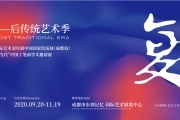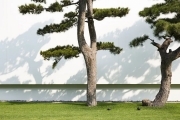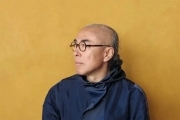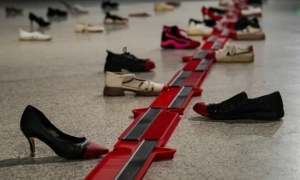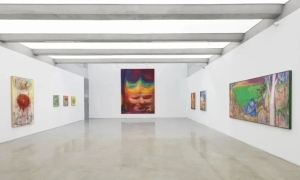黄钢近来的创作将他本身推向国际关注的焦点,他近年参与了多次重要的展览及在拍卖场上成功获得收藏家的亲睐。他近期的创作主要包含了曼陀罗,菩提树,旧皮箱子,五角星系列。我认为他的作品主要探索了抽象艺术的本源:一、艺术仪式化,二、艺术物质化,并且具有独特的技法和气势。
空间的时间感 Upon Time and Space
黄钢将抽象艺术引导到强调社会性,批判性,远离了强调色彩,线条等艺术语言的视觉与心理作用;他的作品超越纯粹抽象,用东方的抽象语言延展了抽象绘画的意义。他从2002年开始就不断地在画抽象画,对他来说,赵无极是他相当心仪的抽象派大师,他对赵的在用笔中融合中国书法技巧和在对画面经营上应用中国式宇宙观特别欣赏,对他的作品上分析,赵无极似乎有意识或无意识的影响了他对抽象画的概念,但就我看来,他的作品相比赵却更加的中国式也更加的西方式。他对空间的营造更立足于再现中国式的宇宙观,这种观点是来自于他受到中国南宋山水画的意境及东方美学思想的影响。
黄钢使用了压克力颜料,结合中国特有的透明植物大漆(lacquer),用特别渲染的方法多次添加。他用作品质感来营造出南宋山水画中的朦胧空间感,造成视觉上对空间的不确定性,进而产生了空间感,他在画面上也大量使用湿笔等中国技法待干之后再不断反复的覆盖上去,一层又一层,有时候他也会将已完成的部分除去,再重新来一遍,最后使颜色之间没有明显的交接线。他所表现的空间感因此是近于中国式的自然观察而不同于西方式的强调视觉透视。
黄钢对画面空间的营造导致他产生了一种独特的用笔,他偏好使用大笔,侧锋强调画面的动感而非细节。他创作时更强调使用画笔的力量和用笔的速度和运动方向。他的用笔造成了空间的流动感,更因此加深了空间的不确定性,不难发现黄钢对画笔的运用基于他长期对中国书法的了解和实践,与其说他的作品是画出来的,倒不如可以说他的作品是写出来的,我认为他的作品中空间感的再现是相当独特而且是相当深刻的。他的空间感并非视觉的再现,而是经由画笔的运动痕迹对观者所带来的时间感,进一步来说,他所营造的空间感是由时间将所再现出来的是一种观者感知上的投射,基于笔者的分析,我们便不难了解为何观者在欣赏黄钢的作品画面时会感到画面在不停的变动,像是一幅活的画,充满灵性。我个人认为黄钢的作品体现了中国道教式的宇宙观,宇宙是变化不断的,就像是由源源不断的力量所衍生而来。这也就是为什么我认为黄钢的作品比赵无极的作品更具中国式的绘画表现及宇宙观,是基于深刻的理解之上的独特实践。
艺术魔法 The Magic of Art
就另一方面来说,我认为黄钢对抽象画和西方抽象画大师康丁斯基的作品产生相当有意义的对话,众所周知,康丁斯基为抽象画的先驱大师,对他而言,抽象画的意义不单是视觉形象上的单纯化,而是一种精神层面上的追求,他的基本着作总结了抽象画中所表现的视觉能量,对康丁斯基来说,抽象画中更重要是说籍由这种能量,观者可以由画面体验到如宗教般的精神力量,这种对抽象画的理解帮助我们解释了黄钢抽象画的另一层触及到的意义。
我们都知道黄钢的创作来源很大部分是根于他对西藏佛教长久的学习和理解,从材料来说,他近期作品是选自西藏的印版经和旧皮箱子,他将印版经或旧皮箱子拼在一起作为画板,从构图来说,他取材于藏传佛教中的曼陀罗为形式,是一种佛教的宇宙观。除此之外,籍由康丁斯基对抽象画的理解,我们现在可以体会到他作品中和宗教的关联表现在我上述谈到的他作品所产生能量上,在这里,黄钢和康丁斯基对绘画的了解不是形式或视觉地再现而是观者冥想的一个视窗,从艺术理论的角度而言,有学者就把艺术认为是一种魔法,不是一种视觉幻觉,而是根植于人类在物质环境中的宇宙生成未知的、原始的、永恒的依存。
物质化的绘画 Materialized Painting
中国当代艺术近几年的发展已开始寻求一种新的艺术概念和美学以脱离自80年代以来以西方形式和图像为主流的现象。这一方面是源于艺术市场上不断求新求变的市场逻辑,另一方面更是源于艺术家对自身创作的要求与满足感,黄钢对近期几个系列反映了他对新的艺术潮流的探索。他的作品强调了架上绘画的手艺、技艺和生活性,他将长年收集到的西藏宗教及生活材料加以加工组合,同时也强调这些材料在生活中的时间性和精神性。他似乎想籍由此将中国的架上绘画拉回到更本质的创作层面上,而非主流中的强调概念及图像似的应用,也就是说,绘画的意义不是在创作后的视觉再现而是包含了创作中的创作过程和创作前材料的选用,绘画的本质是和物质紧密地结合在一起的,因为这些材料具有巨大的能量,经过时空的转换,这些能量被艺术家放大,释放出来。黄钢的强调绘画的物质性和中国当代艺术家反绘画物质性有极大的差别。黄钢作品的特点受到他的经历的影响。黄钢毕业于中央工艺美院环境艺术系,从大学的训练中,他对材料的认识和应用比油画专业的更为深刻。因此在他的作品中他更希望是选用现成物。籍由对现成物的艺术处理,语言转换,使其具有的精神能量按照艺术家的创造思想去发展,他的艺术能将这些现成物所具有的精神力量和艺术产生一种关联。
黄钢对宗教力量的探讨也反映到了政治层面上,在他近期的作品五星系列中,我们可以发现,他将红色五角星或毛泽东的肖像和他的中国式美学及西藏印经版并置,直接的产生了这些红色经典符号和宗教符号的对比,前者是直接的,色彩强烈的;后者是间接的,颜色温和的。黄钢恰好能够将这两者的差别藉由视觉效果表现出来,但我认为,他的作品另外重要的是在表现两者的共同性。藉由并置政治和宗教这看似不相干的思想来邀请观众探索两者的关联,结果是显而易见的,正如他的作品巧妙地展现。这两种思想都是一种精神力的创作物,都是一种信仰。五角星是常出现在社会主义社会的政治符号,但它更常代表一种前卫力量的展现,它代表反叛、革命的力量,对理想主义的最高追求,这种追求不正是和宗教所提倡的理想主义有共同性吗?所以我认为黄钢对政治和宗教的取材不是单纯的停留在形式主义上,而是更深一层的探索两者背后的深层意义。
结论 Conclusion
在中国当代艺术家的创作主题中,除了大家耳熟能详的政治题材或是消费文化符号外,中国的古代文化也是一部分艺术家较为关注,尤其以海外极为国际知名的艺术家为主,如徐冰使用中国的印刷术,蔡国强借用中国烟火,黄永砯采用中国民间宗教及巫术。他们的创作会引起国内外关注的主要原因是他们有系统地、巧妙地将中国古老智慧转变成了当代艺术形式,这既是中国的,又是全球的,既是古代的,也是当代的,正是这种多元性或是矛盾性体现了他们艺术的本质,而我认为黄钢的作品也放在此一脉络来讨论,并为其艺术找到一个学术上的定位,他借用作品来表达中国式的宇宙观,藉由抽象艺术的语言来表达一种无形的精神及能量。
但我认为黄钢的作品不仅于此,他同时也藉由作品来寻找一种属于中国文人式的当代艺术。黄钢出生和成长在北京,从小生长在具有深厚中国文化历史底蕴的家庭,他喜欢收藏艺术品,无论是当代艺术或是古董,他对艺术有着敏锐而深刻的洞察力。在如此强烈的中国文化薰陶下,对他来说,艺术家不是一个职业,更不是一种工作,而是一种生活方式和对事物观察的本能,也就是一种自然而然的审美能力和对事物再现能力的实现。在中国当代艺术中,这种对艺术家个人的认识是很根本的事。中国书画家讲求与自然、山水的融合与对话,而创作是基于此的延伸,相对于西方艺术来说,艺术家较强调概念的再现。黄钢的架上绘画是在两者兼具中显示出其独特性和创作性。
杨心一(美国康乃尔大学艺术史博士)
On Huang Gang’s Creativity of Abstract Painting
Shinyi Yang
Huang Gang’s recent artwork has made him a major/chasing/catchy focus under international spotlight, along with participating in many significant exhibitions and receiving great attention by art collectors in auction. His recent works mainly contain elements like Mandala, Pipal, old luggage case, and star. His works have explored the origin of abstract art, including its ritualization and materialization, as well as developing his own technique and style.
Upon Huang Gang’s abstract painting, he has led art from depicting conventional artistic language – the color and lines – to a stage that emphasizes more on the society and criticism. With Eastern abstract language, Huang’s work transcends pure abstract painting and extends its meaning. In fact, he has been working on abstract painting since 2002, and has always considered Zao Wou-Ki as a great master. The way that Zao blends writing skill of Chinese calligraphy into brushwork and the cosmic arrangement on the canvas both consciously or unconsciously affect Huang Gang’s creation upon abstract painting. But to me, he presents both more of Chinese and Western styles in his own work. The spatial construction is built to represent Chinese conception on cosmos which he derived from Chinese landscape painting and Eastern aesthetics.
Huang Gang adopts lacquer, a special transparent material extracted from Chinese lacquer, to combine it with acrylic and then paints over and over. The texture in work is created in a misty, airy atmosphere which provides spatial uncertainty. On the other hand, he would use lots of wet strokes and then repeatedly covers paints on where he has drawn before. Sometimes he would even discard the finished part just to start it all over again. Thus, the space he presents is close to natural observation of Chinese style, instead of Western perspective.
The way that Huang Gang creates space naturally constructs his own painting skill. He prefers to use big brush so that the side tip could express dynamic momentum. In addition, he emphasizes much on power, speed, and direction of brushwork in order to give painting a sense of floating. It is clear that Chinese calligraphy has planted deeply in Huang Gang’s mind and has further influenced his creation. In a sense, I think the work tends to be finished through “writing” rather than “painting,” and the representation of how he constructs space in painting is indeed extraordinary and profound. To discuss more specifically, the space is projected by the time feeling when audience looks at the painting. Therefore, Huang Gang’s work seems to be moving lively and vividly with spirit. Last but not least, it well-presents Taoist cosmic conception that the universe never stops changing or providing energy. And this is why I consider Huang Gang’s work manifests more Chineseness than Zao Wou-Ki’s work.
Looking from another aspect, I think Huang Gang’s work also generates some very interesting interaction with Wassily Kandinsky’s painting. To a master of abstract painting like Kandinsky, the significance of abstract painting does not merely lie on simplifying what we see for images. It is human being’s pursuit for spiritual strength that better explains. According to Kandinsky’s published writings, abstract painting delivers visual energy. And what’s more important is that visual energy enables audience to experience a religion-like power. As a result, Kandinsky’s interpretation helps us to excavate into a deeper level in Huang Gang’s creation.
It is widely known that the origin of Huang Gang’s creation derives from years of learning for Tibetan Buddhist knowledge. Upon material, he selects Tibetan Buddhist scriptures and old luggage case, and then combines them to become painting board. Upon structure, he adopts Mandala, a Buddhist cosmic conception, to form the major image. And through Kandinsky’s statement, we experiences that religion-like energy for both Huang Gang and Kandinsky regard painting not as a representation about form or vision, but a window for audience to think and meditate. Hence, there are some scholars consider art to be a kind of magic – magic that has long existed in human being’s materialized environment.
In recent years, the development of Chinese contemporary art has begun to seek a brand new artistic conception and aesthetics so as to getting rid of the dominant form and image of Western mainstream since 1980s. The phenomenon is caused from the idea that art constantly seeks for changes, and artists never stop pursuing more self-fulfillment for creating. For example, Huang Gang’s recent series show out his exploration on new artistic trend. It emphasizes technique and life. Moreover, the combination of Tibetan objects also explains how important these materials are in the meaning of time and spirit. It seems that he tries to lead China’s current creation onto a more substantial aspect, instead of keeping using mainstream’s concept. In other words, the meaning of artwork is not only how a painting looks after creation, but includes the creating process and the selection of material. The essence of painting is closely connected to materials for they possess enormous energy to be released by artists. In fact, what Huang Gang emphasizes – the materiality of painting – has a very huge difference with what Chinese contemporary artists oppose. Huang Gang graduated from the Department of Environmental Art (the Central Academy of Arts and Design) where he received much more trainings and application on material than oil paint. Therefore, he tends to utilize the ready-made in his artwork. By transforming the meaning of the ready-made, their spiritual energy is able to develop in the way Huang Gang conceives, so that the spirit poses a connection with his art.
Furthermore, Huang Gang’s exploration on religious energy also reflects political circumstances. In his recent star series, he puts red star or portrait of Mao Tse-Tung together with the Buddhist scripture, causing contrast in boldness and moderation, eye-catchy color and mild tone. It is evident that Huang Gang, through visual effect, skillfully presents differences between the two components, but it is more important that he shows their mutuality. The two ideologies are the products representing spirit and belief. The red star is a political symbol commonly seen in socialist society, but it has a more crucial meaning standing for avant-garde thinking. It represents rebellion, revolution, as well as the supreme status of idealism, which happens to meet the same idealism of religion. This is why I believe Huang Gang does not simply go for formalism when he selects political and religious subjects, but explores deeper meaning behind them.
Among Chinese contemporary artists’ creating subjects, there are commonly-used political issue, consumerist symbol, as well as Chinese ancient culture. The last one, in particular, provokes unique creativity by overseas artists. Works like Xu Bing’s printmaking, Cai Guo-Qiang’s gunpowder, Huang Yong-Ping’s adoptation from folklore belief and witchcraft become great examples of this type. Their creation rouses attention from all over the world mainly because they, systematically and artfully, transfer ancient Chinese wisdom into contemporary art form. This new art is presented in both Chinese and global style, ancient and modern look. And it is the kind of diversity, or contradiction, that manifests what their art is. In this way, Huang Gang’s work is suitable for placing into this genre, and suitable for defining it in academic research.
In general, Huang Gang expresses Chinese cosmic conception through artwork, realizing intangible spirit and energy through abstract art language. Meanwhile, he tries to search an exclusive feature of contemporary art that belongs to Chinese literati. To analyze Huang Gang’s background, he is an artist born in Beijing and he personally also likes to collect artwork, whether contemporary art or antique. The way that he was raised in a family deeply soaked in Chinese culture cultivates him to possess a keen, profound perception toward art. Under such circumstance, it is very natural that being an artist is neither a career, nor a job. To him, it is a life style, an instinct of observing the world, as well as a practice of representing beauty. When traditional Chinese painters stress on the interaction between the nature and human being, Western artists focus on individual concept. Therefore, Huang Gang’s painting manages to balance between the two, showing his uniqueness and creativity.
【编辑:霍春常】



